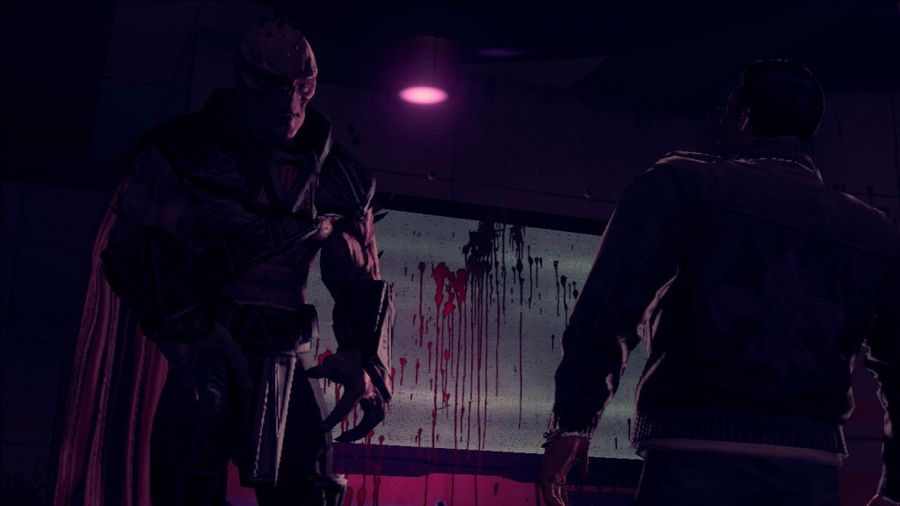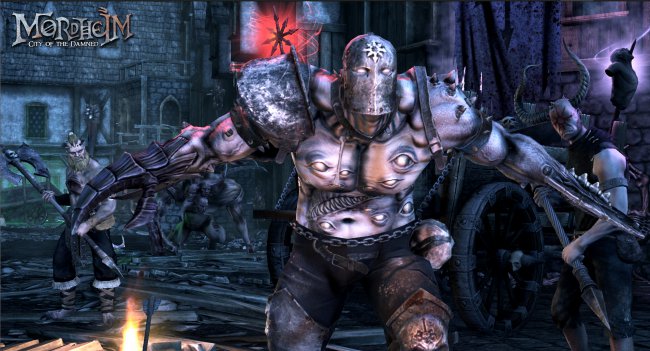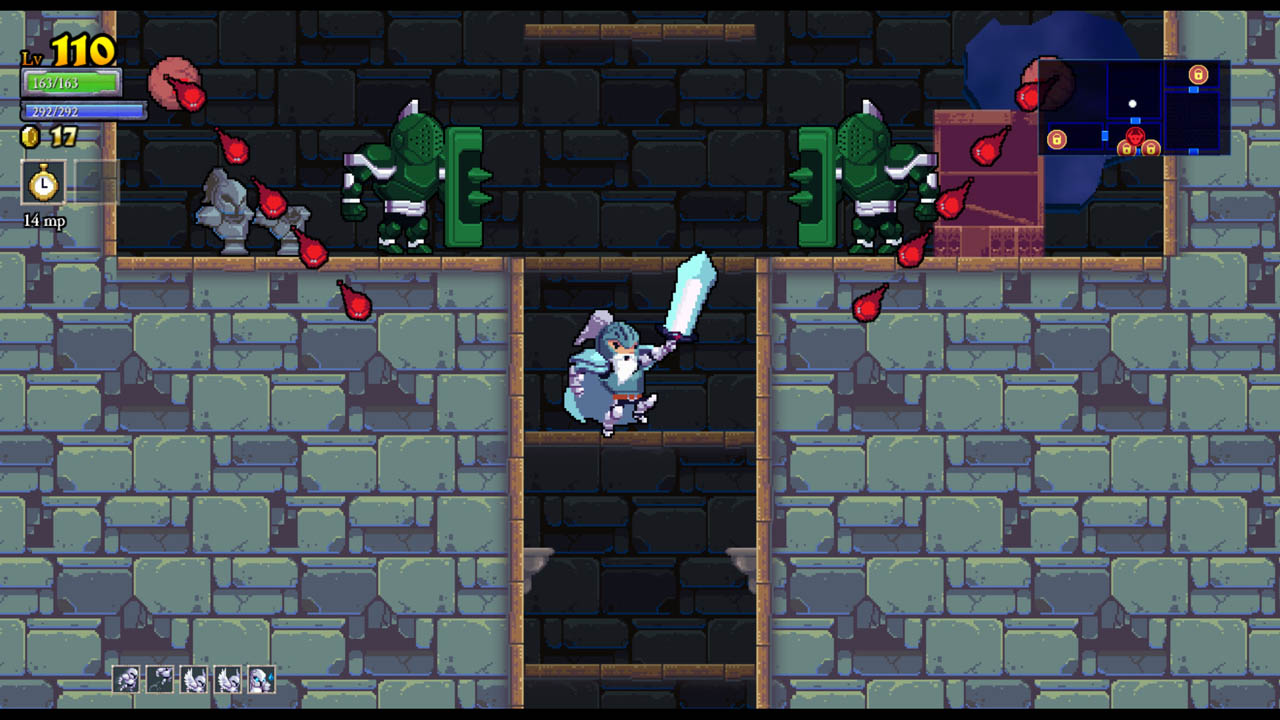

Prison Architect was an adventure for me, and for my guards, and lastly for my prisoners. I cannot count how many riots I had to suppress, how difficult it was for me to manage even a small prison, and during some games how to make a profit. All of that is behind me, especially since I had to do a bit of troubleshooting of my own, when I was faced with a number of unknown or strange problems. This short Tips List aims at providing answers to many different questions regarding Prison Architect, and I hope that in the process you will have a much easier time playing this game.
Building a prison takes times. One day (24 hours) is barely enough to build your structures and your prisoners arrive at the very moment you might still be laying out the cable work, pipes or bringing in the furniture. In short, it is a complete mess, but there is one simple way of solving this problem, turning off Continuous Intake.
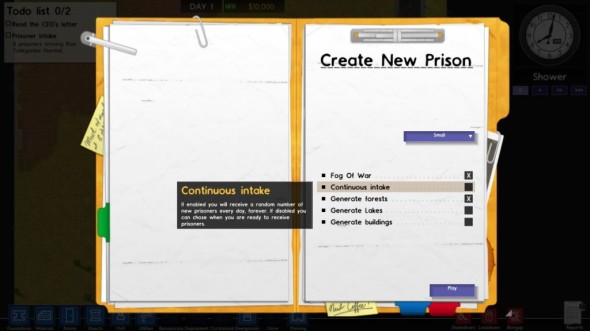
This is the screen that will pop-up when you want to open a new Prison. As you can see Continuous Intake is turned OFF. Now I will be able to control whether prisoners come in.
You might had noticed that your prisoners are STILL arriving, even though you turned off Continuous Intake at the start of the game. Why is that? The answer is rather simple, enter your prisoner tab and close the intake on all prisoner categories. That will disable any incoming “waves” of prisoners, and you can enable or disable them at any time. Just remember, prisoners arrive at 8 AM, every day, so if you are unsure whether your prison will have the space for new prisoners you can close the intake of prisoners at 7:59 AM and you will still be fine.
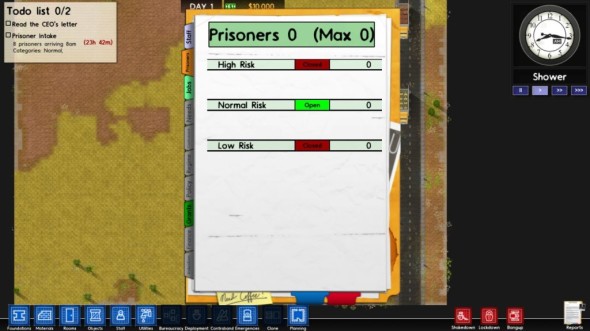
With Continuous Intake switched off you can also decide which of the three categories of prisoners you would want to arrive during the next “wave”. The number of prisoners coming in will be displayed in the top-left corner of the screen.
Turning off Prisoner Intake lets you handle a specific number of prisoners (so you do not go over capacity) and you get to build your starting prison in complete peace. During one game I had to wait 4 whole days to finishing building my small prison complex before I could let in any prisoners.
How much staff you can hire is connected to how much income you produce. In other words, it may be impossible to have enough guards when you first open your prison, HOWEVER as soon as more prisoners arrive you will be free to hire many more guards/staff/administrators, in an instant.
There are a few ways of approaching this problem. Firstly, money is generated through your prisoner numbers. Depending on the Security level of your prisoners (low, medium, high) each prisoner will give you a specific amount of cash at midnight ($50, $100, $150). Of course, that means that having only high security prisoners should be the most profitable option, but if you do not run a tight ship, and you lack in actual security, then do not try your luck with high security prisoners. Medium security prisoners are “just right”, if you plan on running a pretty standard prison.
If you are still building your prison and you run out of money order your workers to cut down all the local trees and sell the lumber. This is a way of getting a bit of extra cash quickly, not the most efficient method by any means.
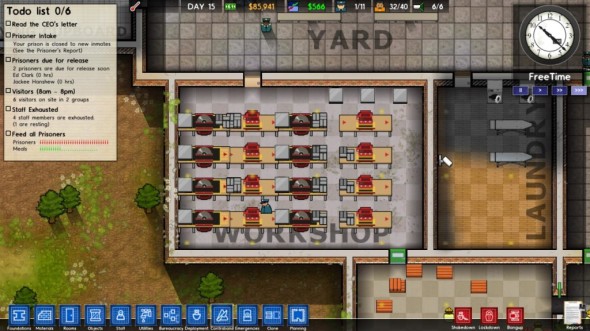
A workshop, ready to deliver license plates to the (presumably) American nation!
Lastly, a workshop. You will have to research prison labor before you can build a workshop, and then you will still have to place plenty of machines to make your business venture worthwhile. After you build your workshop you still need to add “Work” hours on the schedule for your prisoners, and select which jobs can your prisoners perform (through deployment). Produced goods in a workshop may be sold manually or they will be sold automatically during the night (Midnight for License Plates, 1 AM for Wooden Planks).
The only other way to earn money is to take on Grants. Grants (especially in the Alpha) can give you a lot of extra cash that will allow you to construct a small yet functioning prison. Some Grants will give you an additional reward once you complete their associated objectives (usually completing these objectives is like a checklist of having a basic prison).
Riots, random killings, and escape attempts are all connected to one simple variable, unhappiness. Your psychologist (once you research Mental Health) can let you know when your prison is at a breaking point of a riot. By having a Security Chief you can know whether your prisoners are becoming, overall, angrier (if the Danger level is too high a major Riot could spark).
In order to ensure that your prison remains under your control you have to provide you prisoners with many different ways of fulfilling their needs. Let us go over some of the less obvious ones (or such that you might not be made aware of).
Freedom is fulfilled by having work inside the prison, going outside (Yard), calling on the phone and having some free time, in general. However, having a Yard alone is not enough. Take the time to research Prison Labor or build a Common Room so that you can give your prisoners a lot of things to do in their free time. Also ensure that there are a lot of item that your prisoners can interact with. For example, when I had a prison for only 29 prisoners I needed about 12 telephones to ensure all the prisoners could do their calls, when they needed them. In the Common Room I had a number of pool tables and TVs for the prisoners to enjoy. A few weight benches in the Yard will also help. Freedom, according to the Prison Architect wiki, is a measure of how desperately a prisoner wants to escape. From what I could tell it can be brought down (like stated above).
Holding the above in mind, the Yard and Common room offer prisoners a chance to exercise and fulfill their exercise need. Comfort may be regained in the Canteen, by sitting on benches, but the prisoners will also use benches placed at the yard.
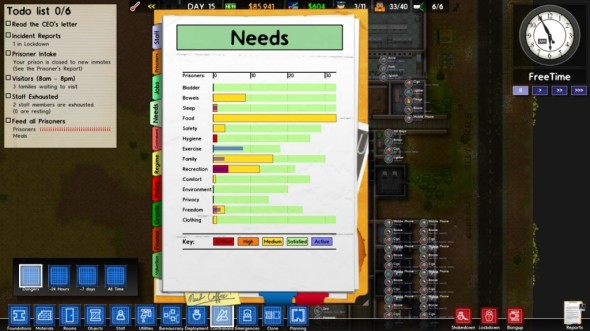
You can view the Needs of your prisoners as soon as you hire a Psychologist.
Clothing and Hygiene go in pairs, more or less. You do not want to stink. Hygiene is easy to fulfill, simply build a shower with enough washing spots for your prisoners to use. As to clothing you need a laundry that is unlocked with prison labor. If you run an efficient laundry you should see a fresh pair of prison clothing on each prison bed by the end of each day. It might seem like a small and unimportant need, but if you ignore the different small needs eventually your prisoners will grow angry.
Family can be fulfilled by using a telephone or having a Visitation Room, where your prisoners can speak with their family. You do not need a large Visitation Room. Having two or three visitation tables is more than enough for a prison of 30.
Aside from the big needs, like Sleep, Food, Hygiene and… well… Poop, there are all these other small needs that you have to hold in mind. In essence, give your prisoners as many things to do as possible. Since you can employ prisoners in your kitchen, laundry, workshop and as cleaners you can have a very efficient and safe prison. Which brings me to my next point.
Rushing off to build a massive prison is not always the best idea. Take your time. Research a number of basic technologies. I recommend researching Prison Labor, Cleaning, Medical Care, Mental Health, Accounting and Security. Prison Labor (once you reach it) offers your prisoners new tasks to get occupied with, and it unlocks the laundry which keeps your prisoners even cleaner. Cleaning unlocks Janitors who will continue to clean your prison, as well as deal with any laundry in their free time. Medical Care is crucial if you expect things to get a bit rough. Prisoners, just like guards, might have to be healed, but you do not need a large hospital. Two beds and two doctors is usually more than enough, unless things get out of control.
Mental Health unlocks the psychologist, who in turn lets you see what do your individual prisoners need. The Accountant lets you keep tabs on your income and expenditure. Security unlocks the Chief, who can help your organize your prison, such as what type of prisoner is allowed into which cell block, as well as view how bad is the situation in your prison (danger level). The above Staff Members allow you to keep tabs on your prison, thus letting you know what your prisoners might need, or when things are getting out of control.
You do not need every single type of room to be successful, but it certainly helps! Starting small also lets you experiment with how many prisoners you can handle with rooms of different sizes (for example, how many prisoners can a single laundry room deal with).
You do not always need a large room so that it can fulfill its basic duty. For example, your Administrators (Warden, Chief, Foreman, etc.) need only a 4×4 room, office desk, chair and filing cabinet. Making the room bigger or adding more items does not speed up research, or improve how they perform their duties. A larger prison cell than a 3×2 room is not really needed.
Some rooms do benefit from being larger, since the larger number of items allows your staff or prisoners to better perform their duties, but even then you must have a certain accurate guess of how big these rooms have to be. For example, you will very rarely need more than five medical beds, unless you constantly have riots. You do not need multiple cleaning closets, but increasing its size allows you to hire more prisoners as cleaners.
Here is a short list of rooms that might benefit and those that will not, from investing in more items/space.
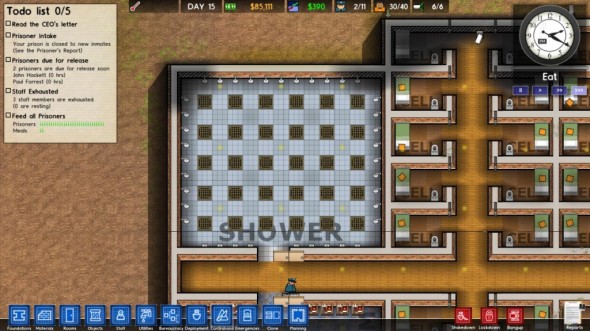
The Shower was designed to allow about 40 prisoners to take a shower. However the cells next to it are all exactly the same. While adding more furniture could make them look fancy in practise your prisoners are just as happy with small cells as they are with bigger ones.
Benefit:
Yard – More Phone Booths, more Weight Lifts, if you have only one Yard make sure it is sufficient for all your prisoners.
Canteen – It needs to be as big as it has to be. If you cannot place enough seats and tables for your prisoners you will have to build a second one, or expand the current one. Remember that a Serving Table comes equipped with only 40 Trays, so you will need more than one if you have more than 40 prisoners coming in to eat.
Kitchen – Like in the case of the Canteen, it has to be as big as the number of prisoners calls for it to be. I read that,the general formula is 2 Cookers – 1 Sink – 1 Fridge for every 20 Prisoners. You can still have more Cookers (that is what I usually do) in order to more rapidly prepare food for your prisoners.
Common Room – Prisoners will not always visit the Common Room, but make sure it is big enough for all those prisoners who need entertainment (Pool, TV).
Workshop – The bigger the workshop the more workstations you can build, and the more prisoners can work in it. Take note, the number of workstations you place does not equal the number of possible workers who can work there. It’s the size of the room that determines how many prisoners can work in the workshop.
Laundry – Just as in the case of the Workshop, the bigger the more people can work in it. To be honest, I had one Janitor and one Prisoner working a Laundry for 29 prisoners and they could keep up with the workload just fine, having more does not hurt and it keeps the prisoners occupied.
Shower – While you do not need an equal number of shower heads to all your prisoners using said showers (they will swap when they are done) you should have enough of them not to cause any unhappiness. Also remember to have enough drains or your shower room and corridor will flood.
Storage – If you need more storage space then a larger Storage is useful, usually you do not need that much storage though.
Cleaning Closet – The larger it is the more prisoners can work as cleaners.
Security – The room itself does not have to be big, but the more CCTV panels you can fit into it the more cameras you can operate around your prison.
Do not benefit:
Cells – Giving a prisoner a larger cell does not appear to have any significant benefit. neither does adding any additional room items.
Solitary – All this needs is a 1×1 room, and a solid door, nothing else.
Morgue – You do not need a huge morgue. If you can fit in a single Morgue Slab you should be fine, unless a lot of people are dying in your prison.
Infirmary – While having more than one bed might be useful your doctors tend to heal prisoners/staff almost instantly, so having one or two beds is usually more than enough, especially if you are employing two doctors.
Garbage – The default Garbage area is usually more than enough for your needs. It would be very hard for you to produce enough trash to overflow it.
Staffroom – Staff appears to rest just as quickly in a large or small room, I am not certain about items however.
Office – Building a larger office, or placing more furniture, does not appear to benefit your administration in any way.
Contraband are items that your prisoners have stolen/smuggled in, and which are considered illegal. There are four categories.
Weapons – Dangerous to all. An armed prisoner who participates in a riot would be a very real danger to your staff and other prisoners.
Drugs – Do not seem to have any visible negative effect (other than being illegal)
Tools – Used for escaping your prison.
Luxury – Not dangerous at all, but it is still contraband.
Contraband is obtained from a number of sources. Family members could smuggle it in during a visit, the prisoner himself might smuggle it in when arriving to your prison, or it was stolen from one of your rooms. For example, a prisoner working in a workshop could obtain heavy-duty tools to escape with, or your canteen’s forks could be stolen for weapons.
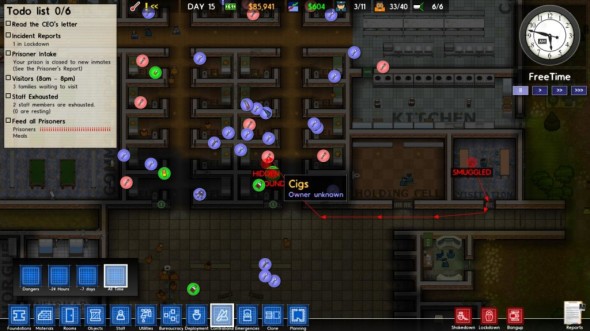
By using the Contraband screen you can check where prisoners could obtain certain pieces of contraband and you can also review what contraband was recently found, and where was it stolen/smuggled from.
You can order a number of possible searches, targeting an individual and his cell, an entire cell block ,or your whole prison. The larger the scale of your search the more unhappy your prisoners could be. Searching a prisoner’s cell is never as bad as searching a prisoner, especially if he is innocent.
Depending on the contraband found during a search a prisoner could be put in Isolation or Lockdown. During a search you may also stumble on tunnels, which gives you a good pretext to search the prisoner who previously lived in the cell.
There are three types of prisoners. Min, Medium and High Sec. Each Prisoner type offers you different rewards, for every day they stay at your prison. 50$ for MinSec, 100$ for MediumSec and 150$ for HighSec. It’s not just about the money though. MinSec prisoners are normally very calm, and you will have a hard time forcing them into a riot. HighSec are the most dangerous, as they tend to be the most murderous, making them explode will be much easier than with Medium and LowSec.
You can make these three types of prisoners share a Cell Block, and if you keep everything under control you should have no problem with HighSec Prisoners either. However, HighSec prisoners may bring in very dangerous contraband, so you will have to regularly check them for firearms and other dangerous tools, or they might cause a serious problem for your prison.
You can decide what types of prisoners will come in, and while there are different types of prisoners a LowSec prisoner could stay in prison for as long as a HighSec prisoner, simply because he might had committed numerous smaller crimes.
If you managed to build an efficient and secure prison then having HighSec prisoners only, for maximum profit, could be the way to go.
Prisoners will build tunnels in an attempt to escape your prison. They will usually try to take the shortest route possible, which means that they could dig their tunnel right next to your patrolling officer, but it is just as likely that they could exploit an area without any guard patrols.
The best way to stop such an escape from happening is to perform prison cell block searches. If you do not want to anger your prisoners start a Cell Block search when all your prisoners are in the yard. This will tag only their cells/toilets, so you won’t have any incidents of unfair searching. If there was a tunnel your guards will find it.
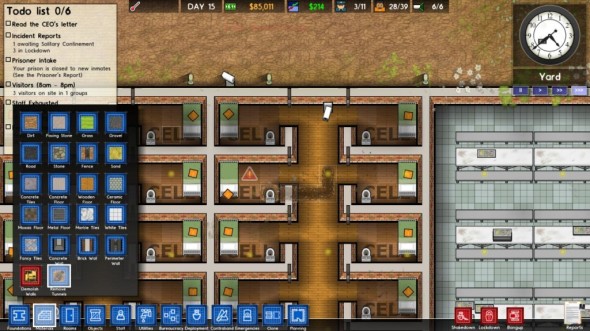
During a recent contraband search a tunnel was uncovered. Workers will have to get rid of it before the cell can be used again.
Making periodical searches, ever two or three days, may be a good idea, if you are afraid that your prisoners are up to something.
A good way of delaying an escape attempt it to build a perimeter fence around your prison. Since a prisoner needs to reach the outer wall having a fence will force him to dig for longer, thus giving you more time to discover the tunnel.
Given the opportunity prisoners may also use other methods to escape your prison. They may get a hold on keys, allowing them to leave the prison at an opportune time, or they may use a clog-up in the door system to run through when nobody is watching. It is very important to sort through the different rooms and areas in your prison, and underline which of them prisoners can have access to, and not (this can be done through Deployment Mode). I had two escape attempts once, when my prisoners, working as cleaners, were allowed OUTSIDE the wall, in order to reach the Administrative Offices, in order to clean them up. Of course, as soon as they left the perimeter they made a dash for the map’s edge, but my guards were faster. Pay careful attention to your Deployment map!
The only thing standing between the prisoners and freedom (not counting all the walls and doors) is your Security Force. Your Guards will do all the escorting, searching, patrolling, fighting and door opening in your prison. They might be expensive but if you want to keep an eye on everything happening in your prison you will need a lot of them.
But Guards alone do not cut it. You need a Chief, and as much research done as possible, in order to maximize the effectiveness of your guards. For example, without the ability to Deploy your Guards, or to set their patrol routes, you will find most of them not doing anything productive, while certain areas, like the Workshop, Laundry Room, or even the perimeter fence around your prison won’t be guarded at all.
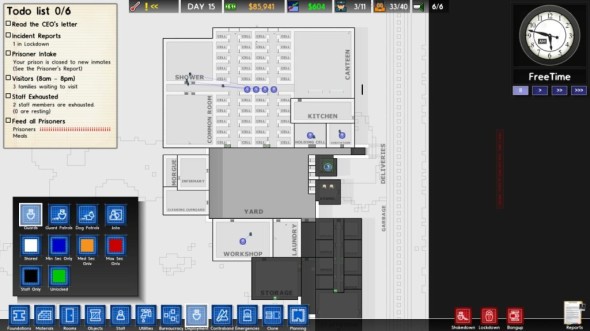
The Deployment Screen allows me to select where and how many guards I want in different areas. I can also set patrol routes for Guards and Dogs. Here you may also decide where do prisoners have access to (in this case, black squares mean “Staff Only” while white squares mean “Shared Areas”.
Deployment will let you choose where your guards will be stationed. If an area is joined (like the cell block on the picture above, which includes the canteen, cells, shower and common room) then the guards will patrol all around it. The larger such an area is the more guards it will need, if you want to keep an eye on everybody. Smaller areas, such as single rooms, need only a single guard.
Setting a patrol route will let your Guards and Guard Dogs patrol on a per-specified route. You can allocate the number of guards who will be patrolling on that route. I found that these Patrols are especially important when it comes to keeping an eye on the area around your prison. In case your searches fail you will have that last line of defense, a Guard or Guard Dog, ready to stop the escapee.
Of course, Guards cost a lot of money. What can you do to save a bit of cash? The only alternative to having Guards patrol areas is to place CCTV cameras. These are operated from a Security room, and each CCTV Panel may control three cameras. CCTV cameras rotate in a near 180 degree range, meaning that they can be used to keep an eye on rooms, corridors, or the vast outside, mildly effectively. A guard is required to sit in the Security Office in order for the Cameras to work (he has to stand on the marked tiles in front of the CCTV Panels).
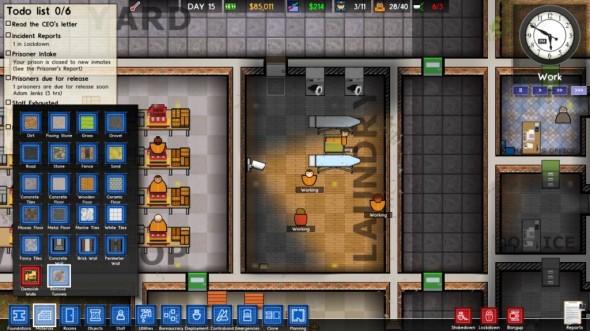
CCTV Cameras have restricted vision, but they can give you at least some idea of what is happening in a room.
When things get out of hand you can call for the Riot Police. You can call three such Squads, with a total of 18 Riot Police Officers. These are tougher and stronger than your ordinary Guards but they are by no means undefeated. If there is a sufficiently big riot, and all the prisoners are armed to their teeth, you could find that the Riot Police are completely helpless. Do not let the situation get out of hand so much!
Eventually you might want to build something bigger, or you got bored of your current prison. What can you do? In your reports click the Valuation Tab, if you have an accountant you will have an option to sell your prison and open a new one. The difference is that you sell your current prison, and receive some bonus cash or penalties, and all that extra money is added to your new prison. For example, when I started a game I had a prison worth $90,000. Thanks to a huge bonus, and a small expansion of the prison after it was finished I sold the old prison and started a brand new one with a $190,000 cash reserve. Since I could take my grants against I could a build a prison worth $250,000!

Tired of your old prison? It’s time to sell it. Here you can see how much will it be worth.
In order to sell a prison you need to fulfill a number of requirements:
1) You need an Accountant
2) Your prison capacity needs to be a minimum of 20
3) Your prison must be worth at least $50,000
You can check your Valuation tab at any time (after you hire an Accountant), and decide when is the best time to sell your prison.
Take note that the “Time Since Last Incident” bonus will zero out when something bad happens. This could be a riot, an escaped prisoner, or even somebody getting beaten up too roughly. Eventually something could happen, such as an angry HighSec Prisoner starting a fight over not getting to shower, and your massive Bonus could be thrown out the window and into a drain, in an instant.
There are many other in-depth guides, especially when it comes to planning out your cell blocks. I recommend checking the Steam Guides, as well as the Prison Architect Wiki, if you have certain questions or doubts about any part of the game.

